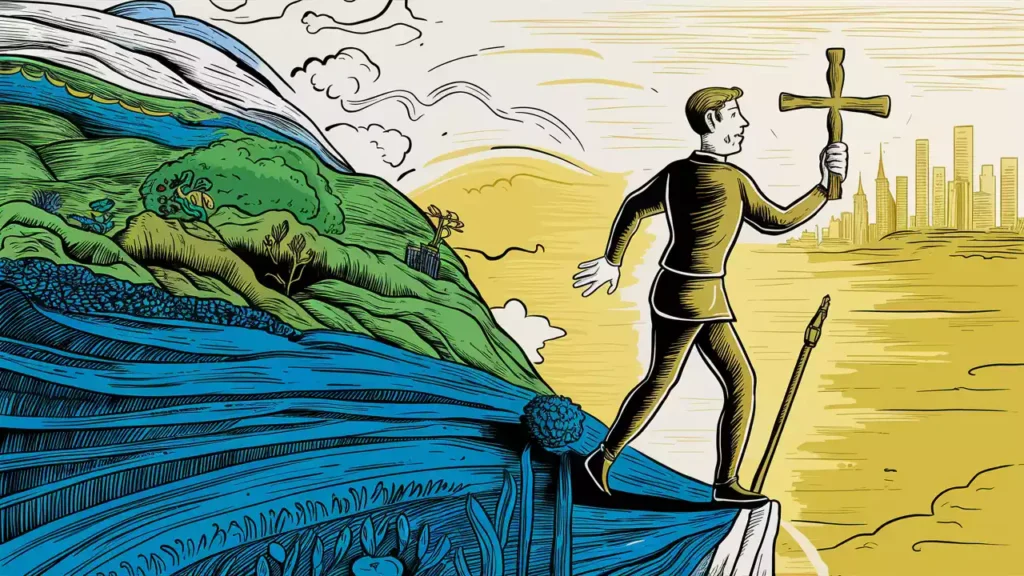Summary
- 1 Key Points
- 2 Beginnings of Christianity
- 3 Christianity in the Roman Empire
- 4 The Council of Nicaea
- 5 The Eastern Schism
- 6 The Protestant Reformation
- 7 Frequently asked questions
- 7.1 How did Christianity influence medieval art and architecture?
- 7.2 What was the role of women in early Christian communities?
- 7.3 How did early Christians practice their faith on a daily basis?
- 7.4 What were the main post-Reformation Christian theological debates?
- 7.5 How has Christianity influenced modern laws and governance?
Christianity began in the 1st century AD. with the teachings of Jesus of Nazareth. His followers, spreading his message, faced persecution but grew greatly in numbers within the Roman Empire. The Council of Nicaea in 325 CE unified Christian doctrine, leading to the formulation of the Nicene Creed. Centuries later, the Great Schism in 1054 divided the Christianity in the Roman Catholic and Eastern Orthodox branches. The Protestant Reformation of the 16th century, initiated by Martin Luther, challenged the practices of the Catholic Church, promoting the Scriptures in vernacular languages and fostering a spirit of individualism. Each stage in the evolution of Christianity offers insights into its profound influence on global history.
Key Points
- Christianity began in the first century CE, based on the teachings of Jesus of Nazareth.
- It spread despite early persecution within the Roman Empire.
- The Council of Nicaea in 325 AD unified the Christian doctrine Through the Nicene Creed.
- The Schism of 1054 divided Christianity into Roman Catholic and Eastern Orthodox branches.
- The Protestant Reformation of 1517 challenged the structure and authority of the Roman Catholic Church.
Beginnings of Christianity
Christianity was born in the first century AD, rooted in the teachings and life of Jesus of Nazareth. You've probably heard about how it began as a small movement within Judaism, but let's explore the origins of Christianity more deeply. It wasn't just about following a new leader; it was a significant message of love, forgiveness and eternal life that resonated with many of those who heard it.

Initially, Jesus' message was transmitted orally by his disciples and early followers, known as apostles. They traveled over lands, sharing his teachings mainly through the spoken word, long before it was formally documented. This period is important for understanding how the fundamental ideas of Christianity were formed and solidified into beliefs that would later be written down in texts such as the New Testament.
Early Christians met in small groups, often in private homes, and their meetings included teachings, communal meals and prayer. This informal network contributed to the organic spread of the religion and its ability to adapt to various cultural contexts outside its Jewish roots. It is fascinating to think about how these humble beginnings contributed to the solid foundation of Christianity, shaping its development long before it became a dominant global faith.
Christianity in the Roman Empire
As Christianity spread, it encountered both acceptance and serious challenges within the Roman Empire. Initially, you might think that the growth of Christianity was a smooth transition. However, the reality was much more complex, especially in the context of the Roman Empire. Early Christians often found themselves at odds with Roman religious traditions and laws, which led to periods of intense persecution.
Roman authorities considered Christianity a threat to public order and traditional Roman values. Christians' refusal to worship the Roman gods was perceived as an act of defiance that could anger the gods and bring misfortune to the community. As a result, this new faith faced sporadic periods of harsh repression, which paradoxically often strengthened the resolve and numbers of Christian believers.
Here is a brief overview to help you visualize the situation:
| Appearance | Description |
|---|---|
| Legal Status | Initially illegal, considered subversive |
| Persecution | Commons, especially under certain emperors |
| Public Perception | Mixed; seen as both moral and subversive |
| Spreading the Faith | Rapid, despite government opposition |
Despite hostilities, the attractiveness of Christianity linked to its universal message of salvation and eternal life was gaining ground among various populations in the Roman Empire, laying the foundation for its future growth.
The Council of Nicaea
In 325 AD, theEmperor Constantine convened the Council of Nicaea, marking a crucial moment in the definition of the orthodox foundations Of Christianity. You might ask why it was necessary. Well, the early church was full of various beliefs and interpretations about the nature of Christ. The Council of Nicaea aimed to unite these different teachings into a cohesive doctrine.
Central to the council's debates was the controversy over theArianism, a doctrine that challenged the idea that Christ was of the same substance as God the Father. This was not only a theological issue; it threatened the unity of the empire, intertwining religious dissent with thepolitical instability.
To address these issues, more than 300 bishops were invited to Nicaea, in present-day Turkey. Their discussions led to the Creed of Nicaea, a profession of faith that affirmed Christ as 'consubstantial' to the Father, effectively counteracting Arian views. This belief has remained a fundamental element of Christian orthodoxy.
The council's decisions did not resolve all disputes in Christianity, but they set a precedent for the ecumenical councils as a means of achieving doctrinal clarity. Your understanding of the Council of Nicaea reveals its crucial role in defining what Christianity is today.
The Eastern Schism
The Great Schism, a monumental split, divided the medieval Christian Church into the Roman Catholic and Eastern Orthodox branches in 1054. This split, known as the Eastern Schism, was not just a sudden event but the culmination of centuries of theological and political disagreements. As you explore this historical rift, you will see that the roots run deep in issues ranging from papal authority to liturgical practices.
Understanding the differences between these two branches can be complex, so here is an overview to help you see the main points clearly:
| Roman Catholic | Eastern Orthodox |
|---|---|
| The pope as the supreme authority | Patriarch as part of collective leadership |
| Filioque clause added to the Creed | Original creed without the Filioque |
| Use of Latin in the liturgy | Greek and local languages in the liturgy |
| Clergy can be celibate | Clergy may marry before ordination |
| Unleavened bread in the Eucharist | Leavened bread in the Eucharist |
These differences were accentuated by cultural, political and geographical separation. Over time, misunderstandings and conflicts intensified, leading to mutual excommunications. You are witnessing the effects of a deep historical division that shaped the course of Christianity, dividing it into distinct paths that continue to diverge. This schism was not just a religious disagreement; it was a crucial moment in Christian history, profoundly influencing the structure and politics of the Church.
The Protestant Reformation
While the Great Schism marked a significant division, another crucial moment in Christian history emerged with the Protestant Reformation, fundamentally questioning the authority and structure of the Roman Catholic Church. You might ask how this Protestant Reformation came about. It all started when Martin Luther, a German monk, posted his famous Twentieth Century Five Theses at the door of the Wittenberg Castle Church in 1517. He criticized various practices of the church, particularly the sale of indulgences, which he claimed undermined the essence of repentance and faith.
This act not only sparked a theological debate; it started a movement that led to profound religious and political changes throughout Europe. Exploring further, you will see that the Reformation encouraged the Bible translation in the vernacular languages, making the Scriptures accessible to a wider audience for the first time. This accessibility enabled people to interpret the Bible for themselves, reducing the clergy's grip on religious interpretation.
The ripple effects were significant. The Protestant Reformation not only created a schism within Christianity leading to the formation of Protestant churches, but also influenced social changes, including the promotion of literacy and individualism. The Reformation was not only a religious revolution; it was a catalyst for modernity.
Frequently asked questions
How did Christianity influence medieval art and architecture?
Christianity strongly shaped medieval art and architecture, with churches and cathedrals reflecting its influence. You may see biblical themes in sculptures, stained glass windows and frescoes, showing religious narratives and lives of saints.
What was the role of women in early Christian communities?
In the earliest Christian communities, women were found as key reference points, often supporting, leading worship and spreading the faith despite social constraints. They were essential, though often unrecognized, in the formation of the early fabric of the church.
How did early Christians practice their faith on a daily basis?
It would turn out that the early Christians practiced their faith daily through prayer, community meals, and Scripture reading. They also met in private homes to worship and support each other in their spiritual journeys.
What were the main post-Reformation Christian theological debates?
After the Reformation, there were major theological debates about predestination, the nature of the Eucharist and the authority of the church. These debates shaped the various branches of Christianity, each with a distinct reflection on divine interpretation.
How has Christianity influenced modern laws and governance?
Christianity has largely influenced modern laws by incorporating moral values such as equality and justice into legal systems. It has shaped government through concepts of human rights and ethical leadership rooted in Christian teachings.
